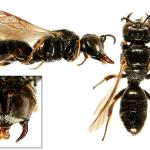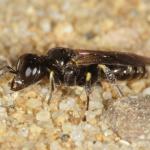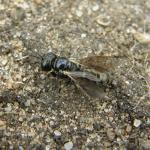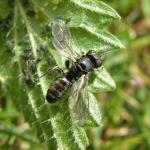A small, black solitary wasp. Identification keys are given in Lomholt (1984), Richards (1980) and Yeo & Corbet (1995).
Widely recorded from localities throughout England, and reaching into northern Scotland (Moray). Overseas, this species is found throughout Europe and north Africa, with the distribution extending eastwards to Mongolia and Manchuria.
This species is not regarded as being scarce or threatened.
Found in a wide variety of open, sunny habitats associated with its feeding and nesting sites and prey habitats.
Univoltine; on the wing from late May to early August.
Nest cells are stocked with a mixture of small homopteran bugs, usually Miridae, and small flies (Chloropidae). Up to 20 bugs may be placed in a single cell. In Fennoscandia and Denmark this species usually only collects Miridae (Lomholt 1984). When returning with prey, the female flies directly into the open nest entrance.
The species nests in level ground in open, sunny situations, usually in small colonies. Richards (1980) notes that the species nests "in soil, usually in sand", suggesting that the species has a requirement for more friable ground. However, a good number of nests have been noted dug into the soil of heavily compacted, well trodden dirt paths (M N Smith, pers. obs.). The nest burrow descends vertically for approximately 10cm before turning horizontally. Individual cells are dug off the vertical portion of the burrow (Lomholt 1984).
Oxeye daisy.
The RDB3 chrysid wasp Hedychridium coriaceum has been noted entering and leaving the burrows of L. albilabris. This distribution of H. coriaceum was mapped in Atlas 3, Map 112 (Edwards & Telfer 2001). In Fennoscandia Lomholt (1984) cites the non-British wasp Myrmosa melanocephala as a parasite.
2006





